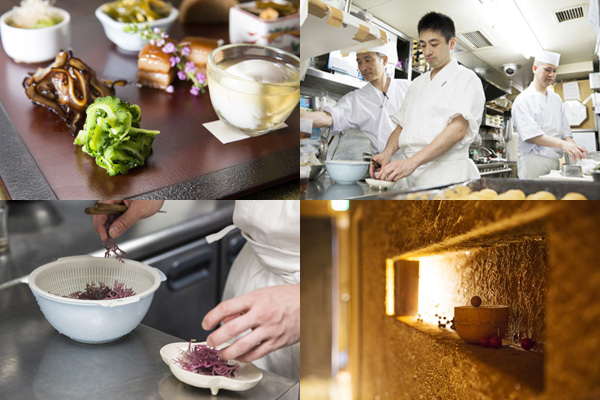Michelin-Starred Okinawan Breakfast: Featuring Okinawan Ingredients
Sep 10,2014
Michelin-Starred Okinawan Breakfast: Featuring Okinawan Ingredients
Sep 10,2014

Special Menu of Akasaka Tantei, Okinawan kaiseki
Akasaka Tantei is an Okinawan kaiseki restaurant that has earned a Michelin star for three straight years. When we had the opportunity to interview the restaurant’s head chef Tanaka Naoki about Okinawan preserves, we also asked him, a little bit selfishly, if he could suggest a breakfast menu, which the restaurant does not ordinarily serve.
“In Okinawa, people say kusuinatan after a meal. The expression literally means ‘this meal was good medicine for me’ and proclaims your gratitude to the people who prepared the food. A central tenet of traditional Okinawan cuisine is eating things that are good for your body. The breakfast items I prepared not only look attractive; they are nourishing to your body.”
There is an old maxim in Okinawa that “food is kusuimun (medicine)’, which is still prevalent to this day. Bitter goya melon is the perfect example. According to the old Ryukyuan text Gyozen Honzo — a treatise on the pharmacognosy of edible plants and animals — goya is: “Tasty, bitter, sweet, neutral, and not poisonous. It removes foul heat, relieves exhaustion, purifies the soul, and sharpens the eyes. It may be eaten daily during the summer months.” Okinawa is acclaimed for its long life expectancy, and this mindset toward food is certainly instrumental in people’s longevity.
At the entrance to Akasaka Tantei hangs a scroll on which Hosokawa Morihiro, the 79th Prime Minister of Japan, inscribed “Nirai Kanai”. Nirai Kanai is an Okinawan folk belief in an ideal paradise across the proverbial ocean that is the fount of fertility and life. Nirai Kanai is where the souls of the living come from, and Nirai Kanai is where the souls of the dead return. Okinawa truly is the island closest to paradise. The more one learns about Okinawan food, the closer one feels to the divine.


The theme of the breakfast is to have a little of everything that’s good for your body. Let’s go through each of the nine petite dishes arranged on the tray above in clockwise order, starting from the top right.
The first dish is taimo taro root that has been deep-fried for a short time and then simmered in a broth. Taimo is an essential part of Okinawan meals served on special occasions. The simmered vegetable teems with the root’s umami.
The second dish is cauliflower lightly seasoned with Ishigaki raayu chili oil, which has become famous nationwide, and garnished with yama karage stem lettuce. It goes perfectly with rice.
At the bottom right is papaya stir-fried irichi style (stir-fried and then boiled in a sauce). The dish is accented by the tropical fruit’s sourness.
At the top of the center column is kubu (kelp) also stir-fried irichi style. Okinawa is consistently one of Japan’s top kelp consumers, even though no kelp is harvested anywhere in the island groups. The reason for its popularity is that during the Edo period (1603 to 1868), Okinawa was a staging ground for kelp from all parts of Japan before being shipped to China. In an age before refrigerators, kelp was a valuable foodstuff for Okinawans because it did not spoil easily.
In the exact middle of the tray is another Okinawan tradition, rafute (stewed pork meat cut into squares). The combination of gelatinized fat and tender, melt-in-your-mouth meat is a delight.
At the bottom of the center column is pure-white jimami tofu, primarily made of groundnuts. Jimami, a legume that grows in the ground, has long been a staple foodstuff that can be harvested without fail in Okinawa, which is struck by typhoons every year that often knock over and uproot other ground crops.
At the top left is boiled and seasoned nabera, the Okinawan term for sponge cucumber. With its faintly sweet and soft texture, it is the real taste of summer.
Next is chiraga, smoked pig snout skin. This dish gives credence to the saying that people in Okinawa eat every part of the pig except its squeals. It’s impressive for its crunchy consistency.
Finally, in the bottom left, is boiled goya. Complemented by rice porridge with fuchiba (mugwort leaves), dragon fruit, and vegetable juice (made from pineapple, shekwasha lemon, goya, and other ingredients), this nonet of dishes is thoroughly satisfying.
After dining on this glorious breakfast, we felt like we had tasted all the ingredients of Okinawa in one sitting. From here, paradise is only a heartbeat away.
